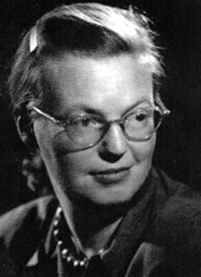
Shirley Jackson
_Shirley Jackson, 1916-1965, one of the preeminent authors of classic American mystery _ _and suspense fiction, best known for her short story “The Lottery.”
SHIRLEY JACKSON
Shirley Jackson, 1916-1965, one of the most brilliant and influential authors of the twentieth century, is widely acclaimed for her stories and novels of the supernatural, including the well-known short story “The Lottery” and the best-selling novel “The Haunting of Hill House.”
Shirley Jackson was born in San Francisco on December 14, 1916, and spent her childhood in nearby Burlingame, California, where she began writing poetry and short stories as a young teenager. Her family moved East when she was seventeen, and she attended the University of Rochester. After a year, in 1936, she withdrew and spent a year at home practicing writing, producing a minimum of a thousand words a day.
She entered Syracuse University in 1937, where she published her first story, “Janice,” and was soon appointed fiction editor of the campus humor magazine. After winning a poetry contest at Syracuse she met her future husband, young aspiring literary critic Stanley Edgar Hyman, and together they founded a literary magazine, Spectre, with Hyman as editor. Both graduated in 1940 and moved to New York’s Greenwich Village, where Shirley wrote without fail every day while they both worked odd jobs. She began having her stories published in The New Republic and The New Yorker, and the first of their four children was born. In 1944 Jackson’s story “Come Dance With Me in Ireland” was chosen for Best American Short Stories.
In 1945, Stanley Hyman was offered a teaching position at Bennington College, and they moved into an old house in North Bennington, Vermont, where Shirley continued her daily writing while raising children and running a household. Her first novel, The Road Through The Wall, was published in 1948. That same year The New Yorker published Jackson’s iconic story, “The Lottery,” which generated the largest volume of mail ever received by the magazine---before or since---almost all of it hateful. “The Lottery” has since been published in dozens of languages, and is still required reading in U.S. high schools. It is possibly the most well-known short story of the 20th Century.
In 1949, the Hyman family moved to Westport, Connecticut, so Hyman could commute to his new job on The New Yorker staff, and Shirley’s second book, The Lottery, or The Adventures of James Harris (a collection of short stories) was published. Their house was often filled with visiting poets, artists, composers and writers, and National Book Award-winning author Ralph Ellison spent months in residence with the Hymans while completing Invisible Man.
In 1951 Jackson’s succession of Gothic novels began with the publication of Hangsaman, and her “The Summer People” was chosen for Best American Short Stories. That year the Hymans moved back to North Bennington, where they would remain for the rest of their lives.
In 1952, “The Lottery” had its first of several adaptations for television. Jackson continued to be a prolific writer of short stories for popular magazines, and in 1953 Life Among The Savages, the first of two humorous family chronicles, was published. “The Lottery” was adapted for stage. In the next few years Jackson published The Bird’s Nest, to great acclaim, and Witchcraft of Salem Village, a non-fiction juvenile volume. “One Ordinary Day With Peanuts” was chosen in 1956 for Best American Short Stories, and also that year, the film version of The Bird’s Nest, “Lizzie,” was released. During the late fifties Jackson published Raising Demons, the second family chronicle, The Sundial, and the one-act play “The Bad Children.”
In 1959 came The Haunting of Hill House, her best-known novel, which has come to be generally regarded as the “quintessential haunted house tale.” That novel has twice been adapted for feature films. In 1961 Jackson received the Edgar Allan Poe Award for “Louisa, Please,” one of the few such awards she ever received during her lifetime. The following year her best-selling novel We Have Always Lived in the Castle was included in the year’s “Ten Best Novels” by Time Magazine.
In 1963, director Robert Wise released “The Haunting,” the first film adaptation of Jackson’s novel, to superb reviews. Jackson was invited to join the teaching staff at the famed Breadloaf Writers’ Conference, and she continued to review children’s books for the New York Herald Tribune. In 1965 Jackson was awarded the Arents Pioneer Medal for Outstanding Achievement from Syracuse University, but illness prevented her from attending. On August 8, at the age of 48, Shirley Jackson died unexpectedly of heart failure during her usual afternoon nap.
The following year, Stanley Edgar Hyman published the first of two posthumous anthologies, The Magic of Shirley Jackson, a collection of short stories and three previously-published novels. This was followed in 1968 by Come Along With Me, the unfinished novel that Jackson was working on at the time of her death, along with sixteen short stories and three lectures. Years later, in 1997, two of Jackson’s children edited Just An Ordinary Day, a collection of many of Jackson’s previously unpublished or uncollected short stories, which received near-unanimous great praise.
Recommended Reading:
Shirley Jackson A biography by Lenemaja Friedman (1975)
Twayne Publishers
Shirley Jackson: A Study of the Short Fiction by Joan Wylie Hall (1993)
Twayne Publishers
Shirley Jackson’s American Gothic by Darryl Hattenhauer (2003)
State University of New York Press
Shirley Jackson; Essays on the Literary Legacy Bernice M. Murphy, Ed. (2005)
McFarland and Company, Inc. Publishers